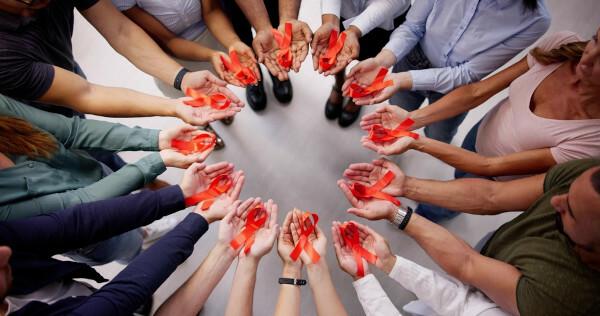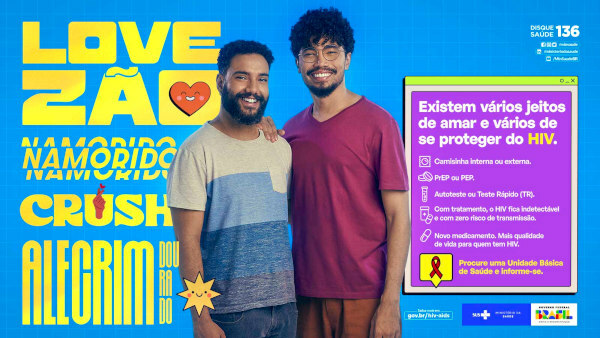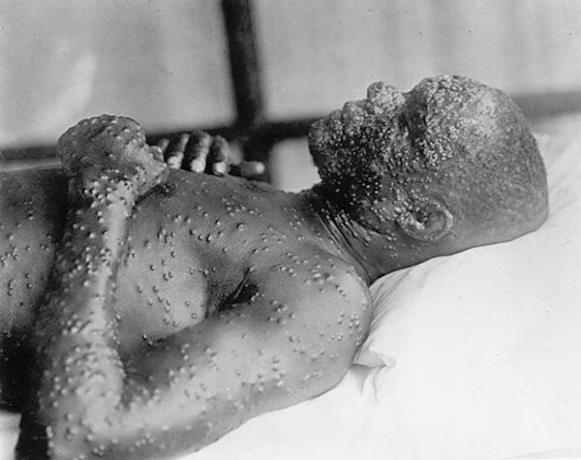Red December is an awareness campaign about HIV, the virus that causes acquired immunodeficiency syndrome (AIDS). The initiative seeks to raise awareness about the importance of early diagnosis, treatment and forms of prevention against HIV and AIDS.
HIV is a virus that affects the human body's immune system. Transmission can occur through unprotected sexual intercourse, transfusion of infected blood, sharing of syringes, and from mother to child during the gestation process.
When not treated properly, HIV causes AIDS, a condition in which the immune system is already compromised. In this way, the body is subject to opportunistic diseases. Being HIV+ (positive) does not necessarily mean that the person has AIDS, as this is a progression of the infection caused by the virus.
Red December also addresses the sharing of prevention and treatment information against other sexually transmitted infections (STI), such as: syphilis, hepatitis B and C, chlamydia, genital herpes and gonorrhea. The campaign was established in 2017 by law nº 13,504.
Read too: December 1st — World AIDS Day
Topics in this article
- 1 - Summary of Red December
- 2 - What is Red December?
- 3 - How important is Red December?
- 4 - Activities for Red December
- 5 - World AIDS Day — December 1st
- 6 - What is AIDS?
- 7 - HIV transmission
- 8 - HIV/AIDS treatment
- 9 - Prevention of HIV/AIDS
Summary about Red December
Red December is a campaign that raises awareness about HIV, the virus that causes AIDS, a disease that affects the human body's immune system.
In 2017, law No. 13,504 was instituted, which made the Red December campaign official in Brazil.
The actions and activities developed during Red December work to share information, promote rights and combat prejudice and stigma associated with HIV and AIDS.
World AIDS Day, celebrated on December 1st, was created in 1988. The date is integrated into the Red December action calendar.
Between 1980 and June 2023, more than 1,123,064 cases of AIDS were reported in Brazil, according to the Epidemiological Bulletin on HIV and AIDS from the Ministry of Health.
Do not stop now... There's more after the advertising ;)
What is Red December?
Red December is a campaign that warns about the importance of early diagnosis of HIV, treatment and from the virus prevention, as well as about other STIs. The initiative encourages debates that combat misinformation and prejudice related to people living with the virus.
In Brazil, the campaign was made official through the lei nº 13,504, in 2017. The focus is to build and apply a set of activities and mobilizations to combat HIV and AIDS. The objective is to guarantee assistance, protection and promotion of the rights of people living with HIV and AIDS.
During the month of December, public bodies, institutions, universities, educational centers, clinics, hospitals, among other spaces, carry out different types of activities on HIV and The AIDS. These actions highlight information of public interest, such as free access to testing and treatment, as well as open dialogues with those living with the virus.
With this, Red December becomes an opportunity to strengthen discussions involving HIV and AIDS, as well as public policies that affect the quality of life of people living with the virus.
How important is Red December?
Red December represents an important initiative for developing informative and reflective actions on HIV and AIDS. The campaign activities bring to society aspects involving diagnosis and treatment, as well as ways to prevent the virus.
Through the campaign, people can have access to information about HIV medication distribution for the Unified Health System (SUS) and carrying out STI tests, for example. In addition to medication that controls the virus in the body, there are also drugs that prevent infection, distributed free of charge.

In this sense, the campaign works to share knowledge about access to rights, in addition to promoting reflections on the condition and debates that combat prejudice.
Activities for Red December

See below some activities and actions of the Red December campaign:
Illumination of public buildings and monuments with red light.
Lectures and conversation groups to discuss the importance of early diagnosis, prevention and treatment of HIV.
Dissemination of audiovisual and digital campaigns in the media through open television, websites and social networks.
Holding events with the presence of researchers, doctors and people who live with HIV and speak openly about their serological condition.
Publication of documents, booklets and literary works that address aspects of HIV and AIDS.
Check out a piece from the 2023 World AIDS Day campaign carried out by the Ministry of Health:

World AIDS Day – December 1st
World AIDS Day has been celebrated on December 1st since 1988. The date was established in the General Assembly of the United Nations (UN) and by World Health Organization (WHO).
Before the date was set, there was a movement that brought together around 200,000 people during the 3rd International AIDS Conference in 1987.. Activists and people living with the virus participated and protested to be heard by the scientific community, as there was still no access to treatment at that time. Since then, December 1st has been marked as a date that reinforces the fight against prejudice, misinformation and stigma associated with HIV and AIDS.
What is AIDS?
AIDS is acquired immunodeficiency syndrome, a disease caused by the HIV virus. This virus attacks the immune system, especially CD4 lymphocytes (defense cells), and quickly multiplies in the blood.
The first time AIDS was recognized was in 1981, by the United States Center for Disease Control.. At the time, adult homosexual men presented with pneumonia and compromised immune systems, which raised alarm among the country's medical community.
In the AIDS scenario, in addition to the biological factors resulting from the disease, social aspects are also included. For a long time it was thought that only homosexuals could become infected with HIV and, consequently, develop AIDS. In this way, a stigma regarding the condition associated with sexuality was consolidated.
In 1987, the process of developing medications against HIV began. That year, the use of zidovudine (AZT) caused a drop in mortality among people living with HIV/AIDS. The first vaccine development centers against the virus were created in 1992 through the WHO Global AIDS Program. However, there is still no proven effective vaccine against HIV, just scientific trials.
The distribution, through SUS, of the first medicine against HIV, zidovudine, began in 1991. National manufacturing began in 1993. In 1996, law 9,313 was established, on the right to access medicines through the SUS.
The progression to AIDS is a public health concern. A total of 52,415 young people, aged 15 to 24, developed the disease between 2012 and 2022, according to the Ministry of Health.
In 2022, 10,994 deaths from AIDS were recorded in Brazil. The mortality rate was 4.1 deaths per 100,000 inhabitants, according to data from the Mortality Information System (SIM), a tool of the Brazilian federal government.

Globally, the number of people who have become infected with HIV since the beginning of the epidemic exceeds 84 million, according to data from the Joint United Nations Program on HIV/AIDS (Unaids). In 2021 alone, there were at least 1.5 million new cases.
To access the full data from the 2023 Epidemiological Bulletin on HIV and AIDS, prepared by the Ministry of Health, click here.
HIV transmission
HIV transmission can occur in the following ways:
unprotected sexual intercourse;
vertical transmission (from mother to child);
blood transfusion;
syringe sharing;
accidents with biological material.
Also access: Syphilis — infection transmitted mainly through unprotected sexual intercourse with someone infected
HIV/AIDS treatment
Treatment to control the action of the HIV virus in the body This is done through the use of medications known as antiretrovirals. People living with HIV, if they are receiving adequate treatment, should not develop AIDS, says infectious disease doctor Kingler Faíco.
Over time, the amount of medications used in the treatment process was significantly reduced. Currently, on average, two tablets are used.
The aim of medicines is to reduce the amount of viruses in the body and, consequently, their power of action.. When a person reaches the undetectable status, this means that they are no longer transmissible, due to the low circulation of the virus in the blood.
The side effects of HIV/AIDS medication are low, and when they occur, they are generally mild, reinforces infectious disease doctor Lissa Rodrigues.
Read the Brasil Escola report that presents interviews with infectious disease specialists about HIV and AIDS by clicking here.
HIV/AIDS prevention
HIV/AIDS prevention is achieved through different strategies. Look:
Use of condoms during sexual intercourse: The condom, male or female, is a barrier method that prevents sexually transmitted infections (STIs) and pregnancy and must be used during sexual intercourse.
Pre-Exposure Prophylaxis (PrEP): the medicine prevents HIV infection. Distribution occurs free of charge by the SUS to specific groups, such as: serodiscordant couples (when one lives with HIV and the other does not), sex workers who have unprotected sex, and men who have sex with men. Monitoring by a doctor is required for its use.
Post-Exposure Prophylaxis (PEP): the medicine is used when there has been unprotected sexual intercourse in cases such as victims of sexual violence. Use must be started within 72 hours after exposure and for 28 days.
Important: In case of exposure and risk situation, carry out HIV and other STI tests! To find out more information about the virus and the disease, call Dique Saúde (136).
Image credit
[1]Jonas Pereira / Senado Agency (reproduction)
Sources
BRAZIL. End inequalities. End AIDS. End pandemics: 01/12 – World AIDS Day. Ministry of Health - Virtual Health Library, [n.d.]. Available in: https://bvsms.saude.gov.br/acabar-com-as-desigualdades-acabar-com-a-aids-acabar-com-as-pandemias-01-12-dia-mundial-de-luta-contra-a-aids/.
BRAZIL. AIDS: etiology, clinic, diagnosis and treatment. Ministry of Health - Assistance Unit, [n.d.]. Available in: https://bvsms.saude.gov.br/bvs/publicacoes/Aids_etiologia_clinica_diagnostico_tratamento.pdf.
BRAZIL. HIV and AIDS Epidemiological Bulletin 2023.Ministry of Health - Health and Environmental Surveillance Secretariat, Brasília, 1st Dec. 2023. Available in: https://www.gov.br/aids/pt-br/central-de-conteudo/boletins-epidemiologicos/2023/hiv-aids/boletim-epidemiologico-hiv-e-aids-2023.pdf/view.
BRAZIL. Law No. 13,504, of November 7, 2017. Provides for the national campaign to prevent HIV/AIDS and other Sexually Transmitted Infections (STIs). Brasília, DF: Official Gazette of the Union, 2017. Available in: https://www.planalto.gov.br/ccivil_03/_ato2015-2018/2017/lei/l13504.htm.
GRECO, Dirceu Bartolomeu. Thirty years of confronting the AIDS epidemic in Brazil, 1985-2015. Science & Public Health, v. 21, no. 5, p. 1553–1564. Available in: https://www.scielo.br/j/csc/a/65XMXBCdW7mX6mMY5Zp4QHS/?format=pdf&lang=pt.
LIMA, Everton.Red December: What do you need to know. Oswaldo Cruz Foundation (Fiocruz), 2. ten. 2021. Available in: https://portal.fiocruz.br/noticia/dezembro-vermelho-o-que-voce-precisa-saber.
Would you like to reference this text in a school or academic work? Look:
AFONSO, Lucas. "Red December"; Brazil School. Available in: https://brasilescola.uol.com.br/datas-comemorativas/dezembro-vermelho.htm. Accessed on December 5, 2023.



